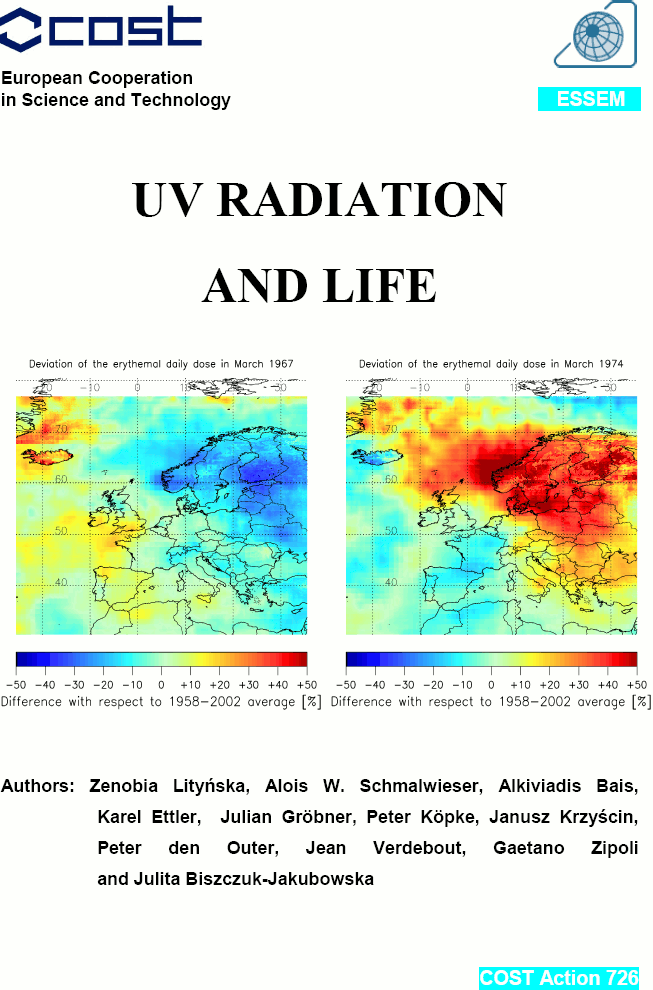

Introduction
Download
Table of content
Last Update: April 2010,
The UV radiation plays an essential role in many processes in the biosphere,
including the influence on the human body, and may be very harmful if UV
exposure exceeds certain limits. The main results achieved in Action 726 are
published in the Final Report and in the e-Atlas, which contains the elaborated
UV maps for Europe for about 50 years and a sample of long-term spectral UV
data.
The knowledge of the ozone and UV changes has expanded considerably since
the “ozone hole” discovery in the early 1980s and the subsequent establishment
of the Ozone Convention in 1985, and the Montreal Protocol in 1987. The
awareness of the potential ozone depletion threat and the resulting increase in
the UV radiation reaching the Earth surface stimulated the world-wide
multidisciplinary research on UV radiation transfer in the atmosphere and its
potential influence on the Earth’s ecosystems. The correlation between the
ozone and UV changes and the climate changes has been recognised.
The COST Action 726 “Long term changes and climatology of UV radiation over
Europe” was established in 2004. Its main objective is to advance the
understanding of the UV radiation distribution under various meteorological
conditions, in order to determine the UV radiation climatology, and to assess the
long-term UV changes over Europe, starting in the 1950s.
The main objectives of this booklet are to show the importance of the scientific
results of Action 726 for the European community, to increase the awareness of
the potential threat of UV radiation to human health, and to urge people to use
appropriate protective measures. This booklet initially provides basic information
on solar UV radiation reaching the Earth surface (section 2.1). Sections 2.2 and
2.3 describe the measurements of UV and the methods of retrieving the UV by
modelling and reconstruction. The main results of the Action, i.e. the
geographical distribution and temporal variability of UV radiation in Europe, are
presented in section 2.4. Chapter 3 describes the biologically effective UV
radiation and its influence on the human body, animals, micro organisms, plants
and the aquatic biosphere. Chapter 4 presents the current expectations on
future UV changes. Appendixes A, B, C show the European dimension of the
COST Action 726 and contain useful web addresses and references.
This booklet is addressed to the broad European community to help further the
understanding of the UV radiation impact on the Earth surface, with its potential
positive and harmful influences, and to stress the necessity of using protective
measures. In particular, we address this booklet to journalists and school
teachers.
This booklet was written by lead-authors but is a result of the collective efforts of
the Management Committee and the four Working Group leaders and members
of the 22 EC COST countries and one non-COST country, for details see
Appendix A.
The COST Action web site: www.cost726.org has been built and is being
managed by Dr Alois Schmalwieser from the University of Veterinary Medicine in
Vienna, Austria. The web site contains all important information on the Action
and main research results including the elaborated UV climatic data for Europe.
Booklet Cover (pdf, 1 MB),
Booklet part 1 (pdf, 10 MB),
Booklet part 2 (pdf, 1 MB),
1. Introduction
2. Solar UV radiation
2.1. Factors influencing UV radiation
2.2. UV Measurements
2.3. UV modelling
2.4. Geographical distribution and temporal variability of UV radiation in
Europe
3. Biologically effective radiation
3.1. Biological effects of UV radiation on human body
3.2. UV Radiation and Animals
3.3. Micro-organisms and UV radiation
3.4. UV radiation and Plants
3.5. UV and aquatic systems
4. Expectations for the future
Appendix A: Reference Institutions in the COST726 Countries
Appendix B: List of www pages with UV information
Appendix C: List of reference publications
by A.W.Schmalwieser